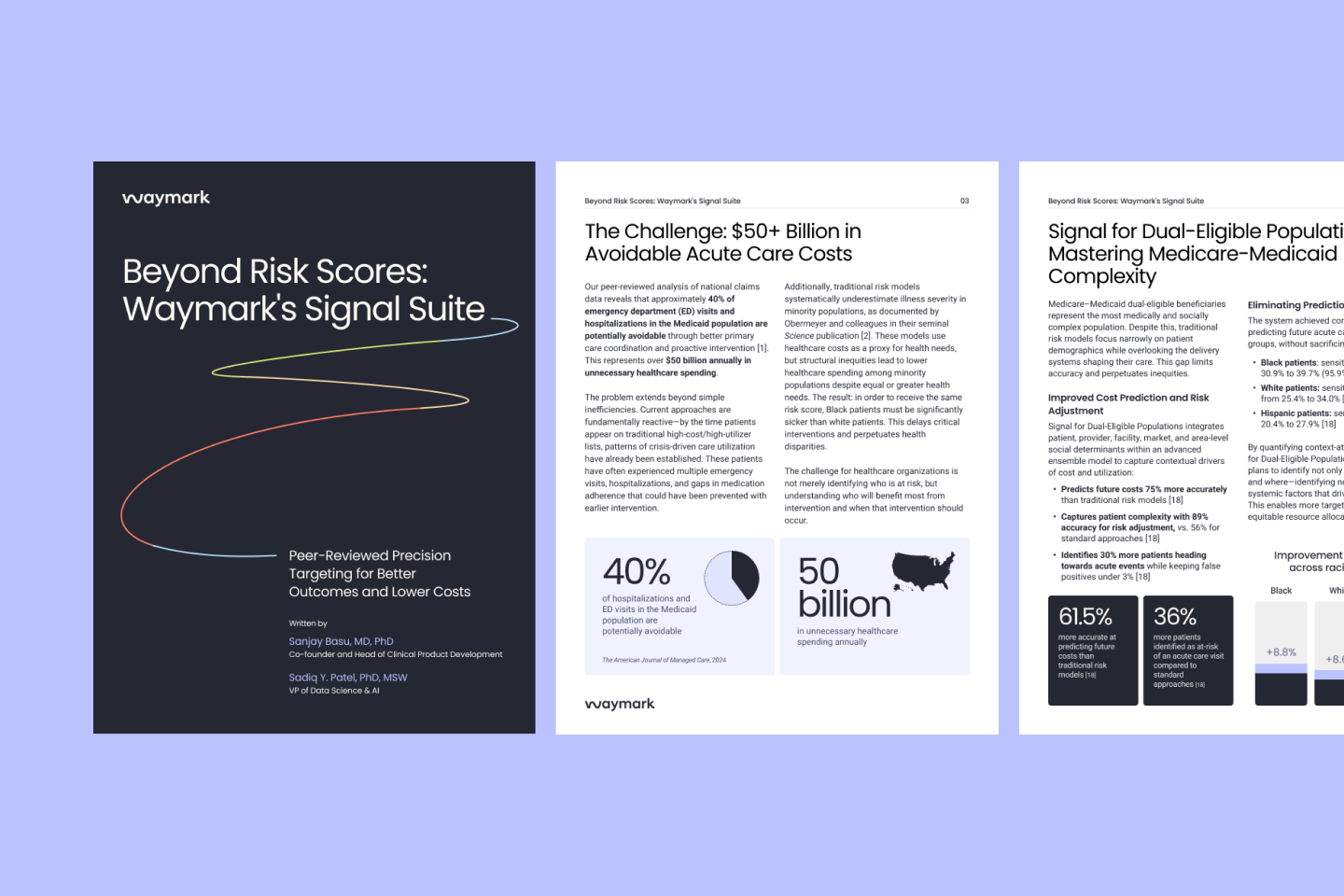Healthcare organizations serving Medicaid populations face a persistent challenge: approximately 40% of emergency department visits and hospitalizations in this population are potentially avoidable, representing over $50 billion annually in unnecessary spending. Yet traditional risk prediction models remain fundamentally reactive, identifying patients only after crisis-driven care patterns have already been established.
Waymark has just released a new whitepaper summarizing our peer-reviewed research on how Waymark's Signal Suite addresses these limitations. The paper, written by co-founder and Head of Clinical Sanjay Basu and VP of Data Science and AI Sadiq Patel, explores the data science powering our predictive models and their validated impact across four core Medicaid populations.
Four Models, Validated Results
Signal for Rising Risk identifies which Medicaid patients need proactive support before acute events occur. Published in Nature Scientific Reports, our research demonstrates >90% accuracy in predicting future avoidable hospital and emergency department visits. Unlike traditional cost-based models that systematically underestimate illness severity in minority populations, Signal for Rising Risk achieved equalized predictive accuracy across all racial groups while identifying three times more at-risk patients than standard approaches.
Signal for Quality Improvement addresses a fundamental resource allocation challenge: which patients with open HEDIS quality gaps are unlikely to complete preventive care without assistance? Our model demonstrates 85% accuracy in predicting which patients will benefit from proactive outreach. In our analysis of 14 million Medicaid enrollees, this precision targeting approach increased preventive care gap closure by 35% compared to traditional methods.
Signal for Maternity provides early warning for high-risk pregnancies—a critical capability given persistent maternal health disparities. Peer-reviewed research found the model identifies high-risk pregnancies 55 days earlier than existing approaches by leveraging pre-conception and early pregnancy signals often invisible to conventional prenatal risk assessments. The model accurately identifies four out of five high-risk pregnancies while maintaining 94% specificity and demonstrating zero racial bias across patient populations.
Signal for Dual-Eligible Populations tackles the complexity of Medicare-Medicaid beneficiaries by integrating patient, provider, facility, and area-level social determinants. Signal demonstrates 80% accuracy in predicting future avoidable acute care, with 75% improvement in cost prediction over traditional risk models. Perhaps most importantly, the model improved prediction sensitivity across all racial groups; Black patients saw sensitivity improve from 30.9% to 39.7%, while maintaining high specificity.
Beyond Prediction: Identifying Who Benefits Most
Our targeting frameworks – which are built into every Signal model – identify which Medicaid patients need support, who would benefit the most, and which interventions to provide. This whitepaper explores how our reinforcement learning framework addresses complex care challenges by learning from thousands of physician-supervised care team decisions to identify both next best actions and optimal intervention sequences.
The whitepaper also details our heterogeneous treatment effects (HTE) framework, which moves beyond simply identifying risk to predicting who will benefit most from specific interventions. This approach addresses a fundamental gap in traditional population health management: a high-risk patient isn't necessarily one who will benefit from outreach, while a lower-risk patient with specific needs may benefit substantially.
Our prospective cohort analysis across 9,600 Medicaid patients, outlined in the whitepaper, found that benefit-based prioritization resulted in a 49% reduction in acute events compared to traditional risk-based targeting, with $123 in additional PMPM cost savings. Our peer-reviewed outcomes research, published in NEJM Catalyst, demonstrates more real-world results: 20% reduction in avoidable emergency department visits, 48% reduction in avoidable hospitalizations, and $2,347 per member per year in savings with a 3:1 return on investment in the first year.
Download the Full Whitepaper
The complete whitepaper includes detailed methodology, implementation science approaches, AI governance frameworks, and a comprehensive bibliography of our peer-reviewed research.
Download "Beyond Risk Scores: Waymark's Signal Suite" to explore how these predictive models identify, prioritize, and intervene with at-risk Medicaid populations.



